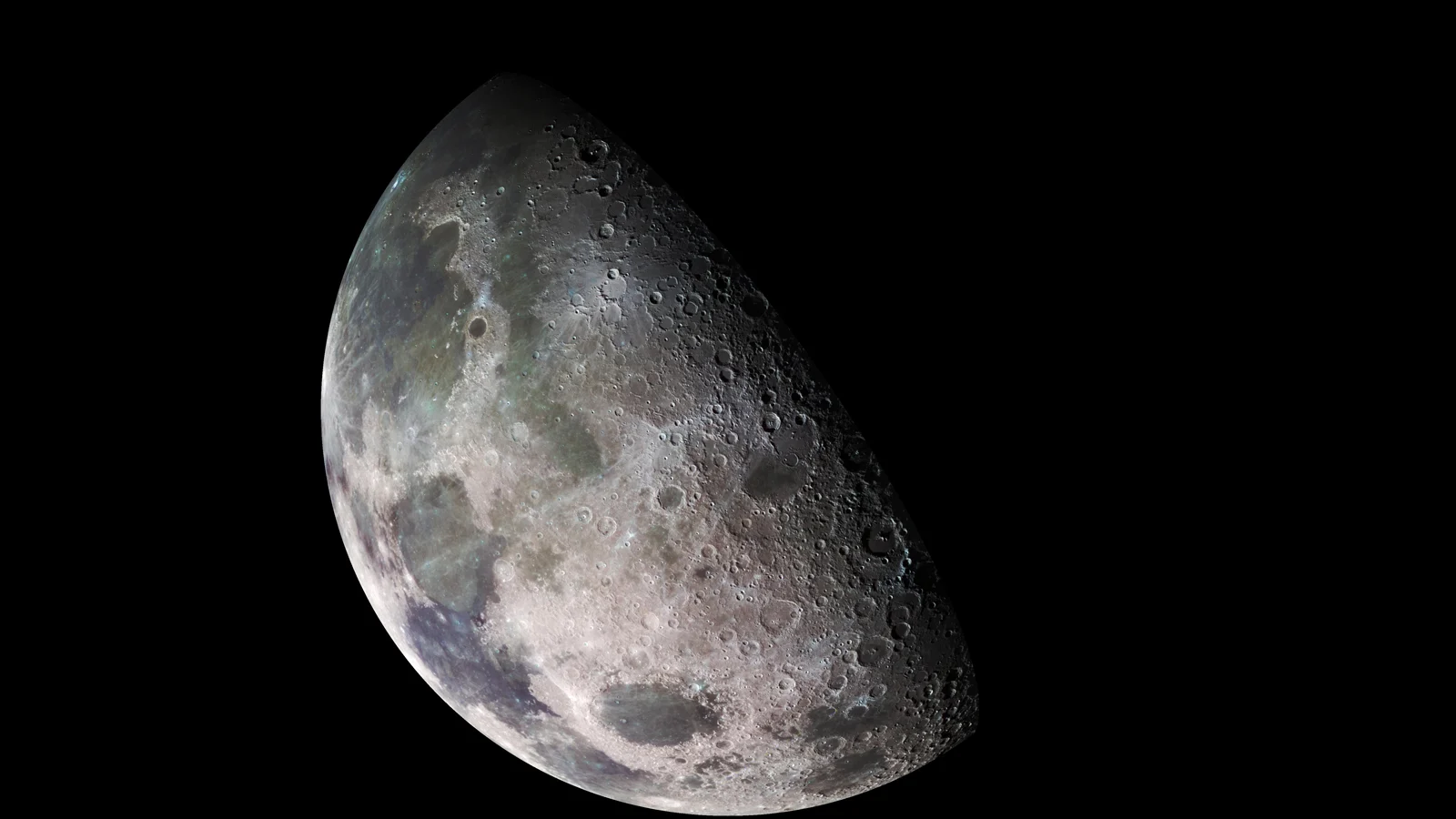
An out-of-control rocket slammed into the Moon
Initially thought to be part of a SpaceX rocket, this booster crashed into the far side of the Moon.
A piece of space junk apparently just crashed into the Moon.
(This article was originally published on February 15, 2022, and has been updated to reflect new information on the story.)
In October of 2014, a Long March 3C rocket lifted off from the Xichang Satellite Launch Center in southwestern China. Perched atop it was Chang'e 5-TI, a test flight for China's 2020 lunar sample return mission. On its way to space, this rocket split into three different parts. The first stage pushed the payload through the thickest part of the atmosphere, then detached and fell back to Earth. The second stage got the spacecraft to orbit and was jettisoned as well. Finally, the third stage booster put Chang'e 5-TI on course for the Moon and then released the spacecraft so it could go about its mission.
After coasting with the spacecraft for nearly a week, this third stage booster passed the Moon on October 28 and was subsequently forgotten.
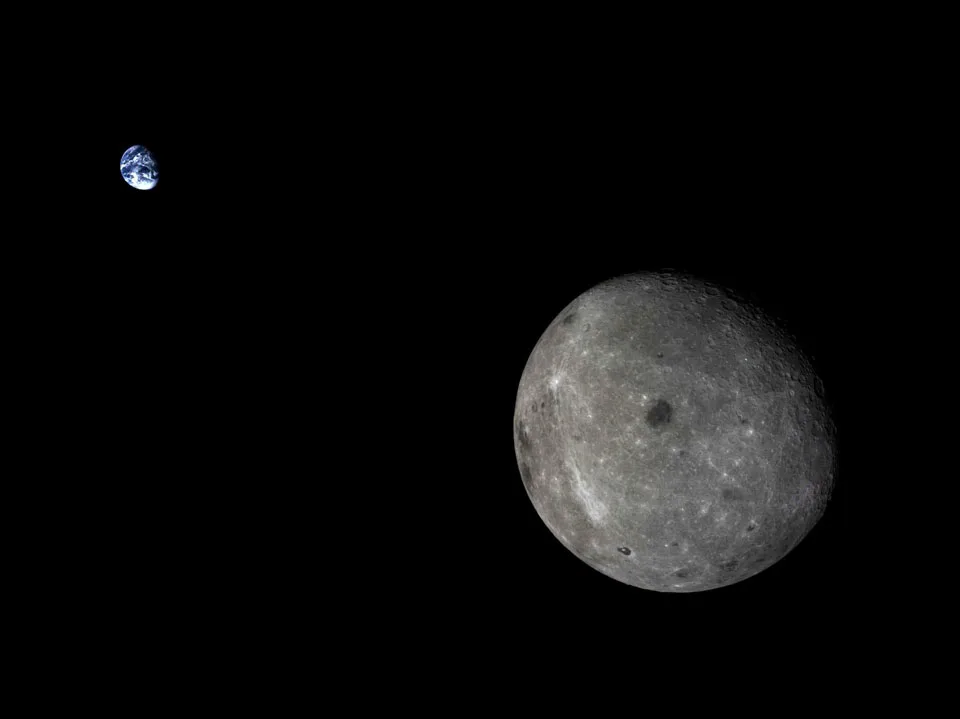
This image of the Moon and Earth together was captured by China's Chang'e 5-TI mission from a position beyond the Moon's orbit. Credit: CNSA/Xinhuanet
Fast-forward to January 2022.
Starting on the 15th, astronomers searching the night sky spotted a 'new' object passing overhead. When they compared its path with objects seen in the past, their observations matched up with the orbit of a piece of space junk named WE0913A that was identified in early 2015. It was that same third-stage booster from China's lunar test mission! After whizzing around the Earth-Moon system for over six and a half years, it was finally picked up again.
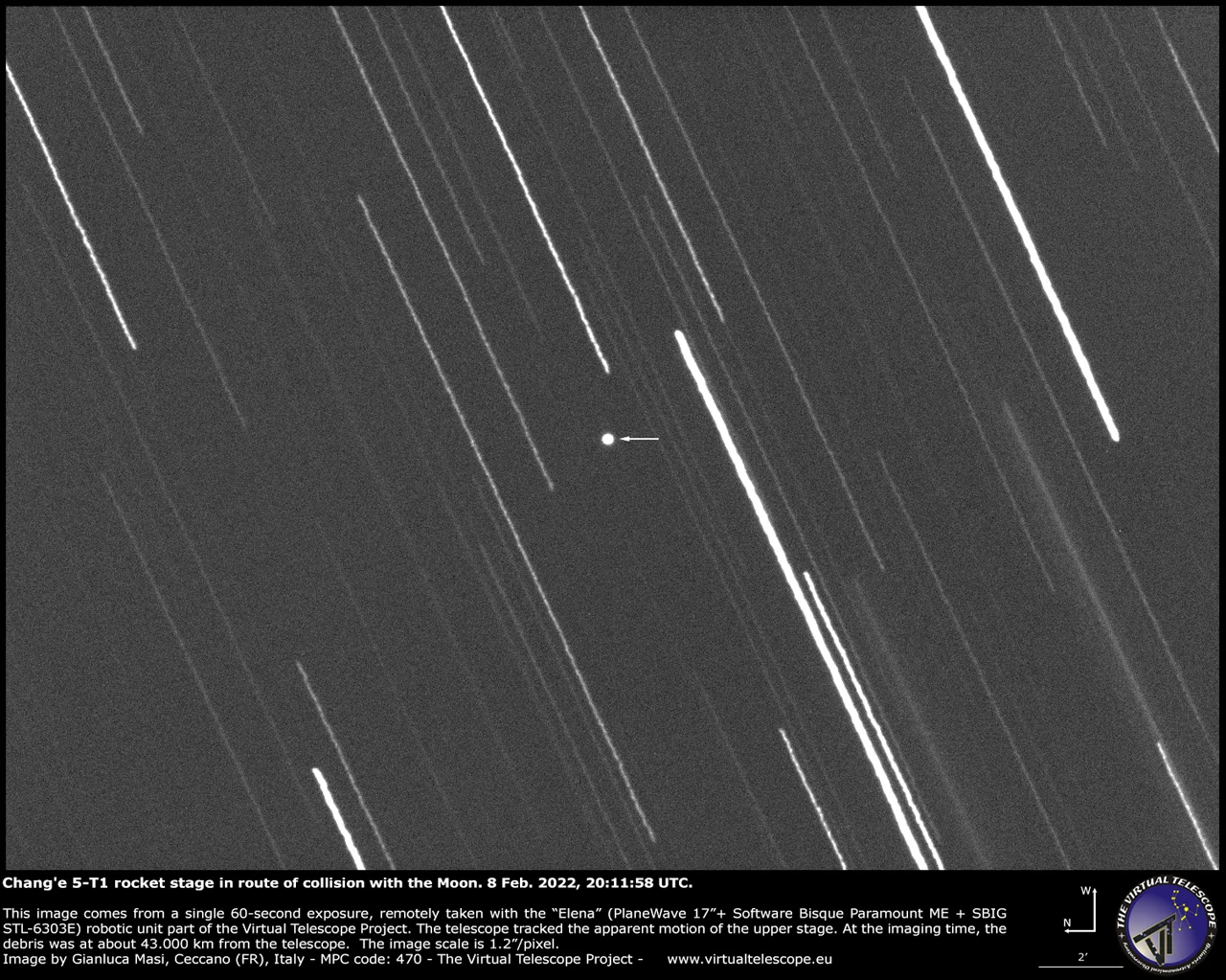
The bright point at the centre of this image (indicated by the arrow) is the Chang'e 5-TI third stage booster. The streaks are background stars, stretched into lines during the 60-second exposure time of the picture. The image was captured via the Virtual Telescope Project by Italian astrophysicist Dr. Gianluca Masi. Used with permission.
Computer simulations of its orbital path revealed that the timing of these observations was quite remarkable. Due to an exceptionally close encounter with the Moon on January 5, this object was only going to make two more passes around the Earth-Moon system. After that, it would then slam into the lunar surface and be destroyed.
As shown in Tony Dunn's animation, in the Tweet below, the elliptical orbit of this object went through a sudden change as it flew past the Moon in early January. A follow-up encounter in February causes another deviation in its orbit, and as a result, it collides with the Moon in early March.
WHERE WILL IT IMPACT? WILL WE SEE IT?
According to Bill Gray, the astronomer who discovered the impending crash of WE0913A, it was expected to impact on the Moon's surface at 7:25 a.m. EST on Friday, March 4.
Using observations and the orbit and rotation of the Moon, Gray traced the location of the impact to Hertzsprung Crater on the far side of the Moon.
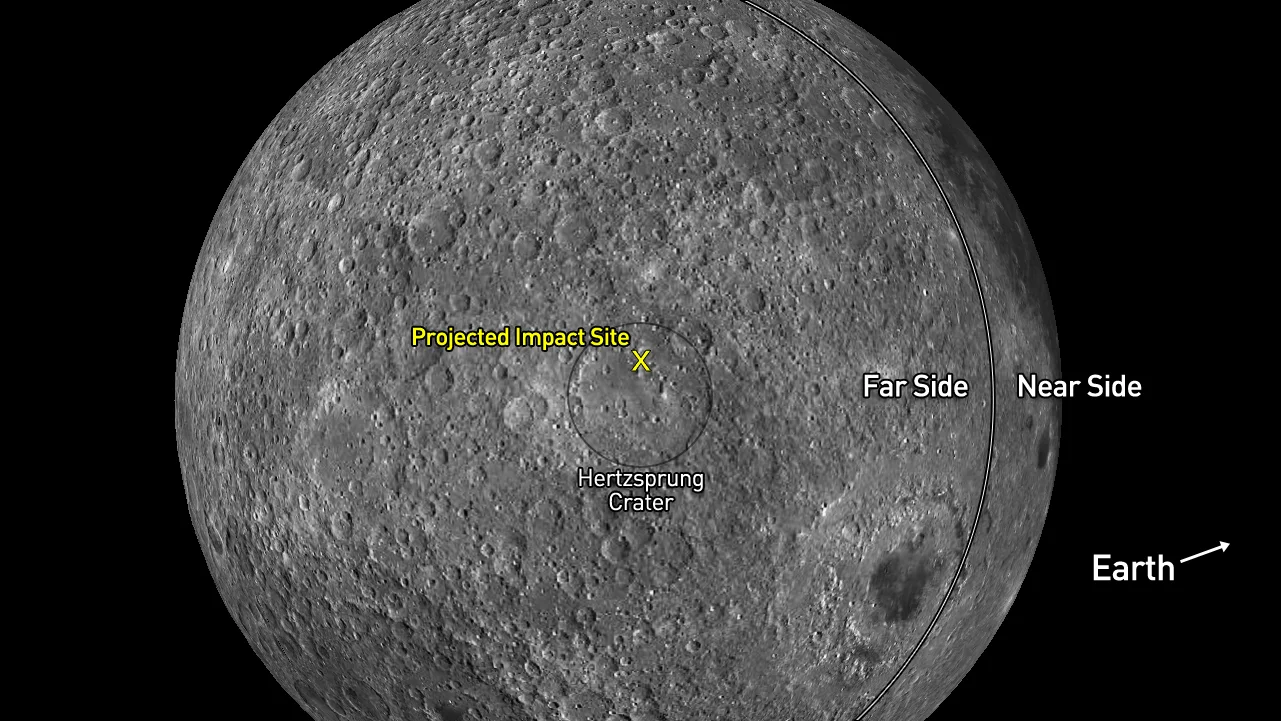
The Chang'e 5-TI booster is expected to slam into the northern end of Hertzsprung crater, a large impact crater on the far side of the Moon. Credit: NASA/LROC/ASU/Scott Sutherland
As for whether or not it was visible from Earth, unfortunately, since the Moon was below the local horizon at the time, and the location of the crash is on the other side of the Moon from us, we were not be able to see it happen.
"I think," Gray wrote on the Project Pluto website, "that the impact itself will have to go unobserved. (Certainly from Earth, since the bulk of the moon is in the way, and even if it were on the near side, the impact occurs a couple of days after New Moon.)."
Also, while the meteorite that hit the Super Blood Wolf Moon in January 2019 produced a visible flash of light, this booster wasn't travelling fast enough when it hit to do the same.
There are spacecraft orbiting the Moon, and Hertzsprung Crater was in full sunlight at the time of the crash. However, it is not known if the timing worked out for any of these spacecraft to see it as it happens. NASA's Lunar Reconnaissance Orbiter will eventually image the site as part of its regular operations, and it may find a new crater there in the aftermath of the impact.
Watch below: Did you know Earth has a 'Space Graveyard'?
WAIT, WASN'T THIS A SPACEX ROCKET?
When this story first broke in late January, it was thought that this booster was the second stage from the launch of a SpaceX Falcon 9 rocket. According to Gray, this assumption originated in early 2015.
When WE0913A was first spotted, calculations showed that it had passed by the Moon in February of 2015. Coincidentally, NOAA's Deep Space Climate Observatory (DSCOVR), which had launched on February 11, had apparently passed by the Moon at roughly the same time, on its way to Lagrange Point 1. So, Gray said that it made a certain amount of sense that this object could have been the second stage of the rocket that got the satellite to its destination. (It couldn't have been the satellite itself, though, since the object continued on an elliptical orbit around the Earth and Moon, while DSCOVR is still out at L1).
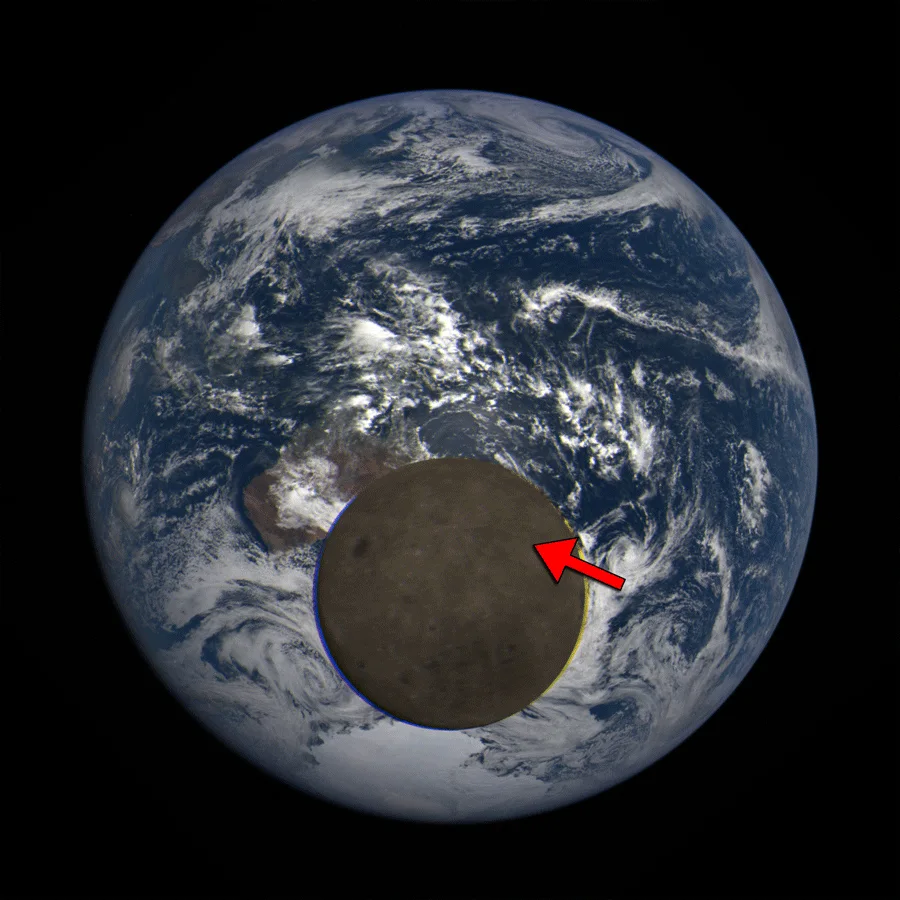
This telescopic image was taken by NASA's Earth Polychromatic Imaging Camera (EPIC), on board the DSCOVR satellite, on February 11, 2021. The red arrow indicates the location that the Chang'e 5-TI booster is expected to impact. Credit: NASA/Scott Sutherland
However, once the story broke that this object was going to hit the Moon, other researchers took a look at the data.
In an update on his website from Saturday, Gray wrote that he was contacted by Jon Giorgini at NASA's Jet Propulsion Laboratory. Giorgini runs JPL's Horizons system, which is the database that keeps track of every known object in the solar system. The data he had told a different story about DSCOVR's trip to L1. He said that although WE0913A had made a close pass by the Moon, DSCOVR had not.
"It would be a little strange if the second stage went right past the Moon, while DSCOVR was in another part of the sky," Gray wrote. "There's always some separation, but this was suspiciously large."
Looking at the data again, Gray ran the orbit of WE0913A back past the launch of DSCOVR to see if any other missions could account for it. He found a lunar flyby for the object on October 28, 2014 — the exact same date that the third stage of Chang'e 5-TI Long March 3C rocket passed the Moon. Making a few logical assumptions about the object's trajectory led him straight back to the mission's launch from Xichang.
"To add to the new evidence," Gray wrote, "Jonathan McDowell has sent orbital elements for an amateur radio cubesat that got a 'ride share' with the booster, and it's a very close match."
The cubesat Gray refers to is the Manfred Memorial Moon Mission, which launched along with Chang'e 5-TI, and was permanently attached to the rocket's third stage. Apparently, the 19 days' worth of signals 4M sent, which were passed along by Jonathan McDowell, an astronomer with the Harvard-Smithsonian Center for Astrophysics, closely matched the orbit of WE0913A.
So, Chang'e 5-TI's third stage booster became the next best candidate for this doomed object.
WHAT DID CHINA SAY ABOUT THIS?
In a press conference on February 21, China's Foreign Ministry Spokesperson, Wang Wenbin, stated that "According to China's monitoring, the upper stage of the Chang'e-5 mission rocket has fallen through the Earth's atmosphere in a safe manner and burnt up completely. China's aerospace endeavors are always in keeping with international law. We are committed to earnestly safeguarding the long-term sustainability of outer space activities and are ready to have extensive exchanges and cooperation with all sides."
What Wang Wenbin said, above, is true. The upper stage of the Chang'e 5 mission did burn up in Earth's atmosphere. However, remember that there were two Chang'e 5 moon missions. The first, launched in 2014, was the "Chang'e 5-TI" test mission. The second, launched in 2020, was the full Chang'e 5 sample return mission, which sent a service module and lander to the Moon. The lander touched down in Oceanus Procellarum on December 1, 2020, collected samples, and then launched those samples up to the service module for return to Earth. After dropping the sample capsule off, the service module then re-entered the atmosphere and burned up on December 17, 2020.
According to Gray, he believes that Wang Wenbin confused the two missions in his statement.
"I should note that many have gotten these two missions mixed up before at one time or another. (Picture my hand raised here.)" he wrote in an update. "Given that, I think this was probably an honest error on the part of the Foreign Ministry."
SHOULD CHINA BE HELD RESPONSIBLE?
There has been some mention of, first SpaceX and now China, being "held responsible" for this lunar impact. The truth is, though, there really is nothing to be accountable for here.
The surface of the Moon is littered with crashed pieces of technology. These ended up there, either intentionally or unintentionally, from at least 58 different missions since the late 1950s.
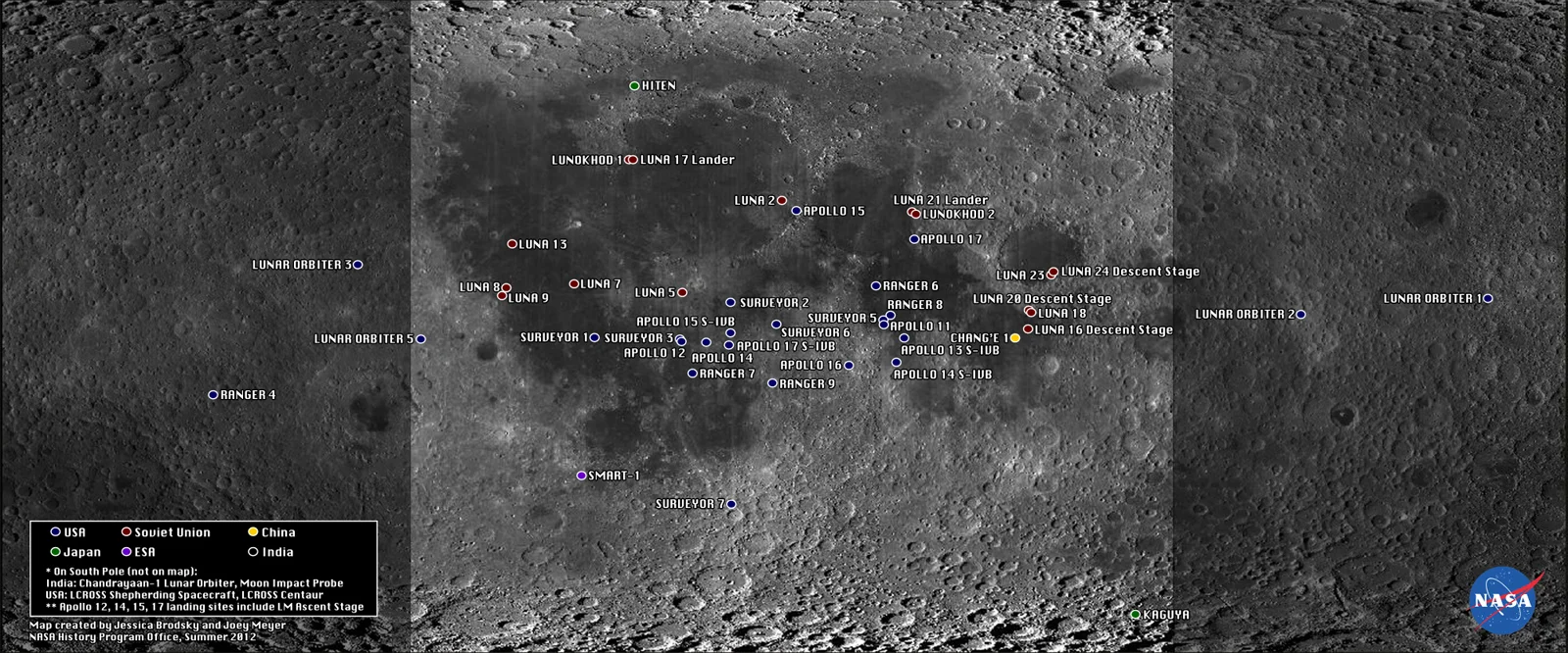
This map of the Moon's surface shows the human artifacts left there from 1959-2012. Credit: NASA History Office
The first was Luna 2, a Soviet spacecraft launched on September 12, 1959, and intentionally crashed into the lunar surface about two and a half days later. Before this Chang'e 5-TI booster, the most recent object that impacted with the Moon was likely the 'ascender' module of the 2020 Chang'e 5 sample return mission, which — after delivering its payload back to the orbiter — fell back to the lunar surface on December 7, 2020.
So, this booster isn't the first object built by humans to slam into the Moon. It certainly won't be the last, either. While space junk is definitely a concern, it is actually better to have these objects crash, since they can do far more harm if left in space. As a bonus, if the Lunar Reconnaissance Orbiter can capture images of the crater produced by this impact, we may be able to get some useful science out of the event, as well.










